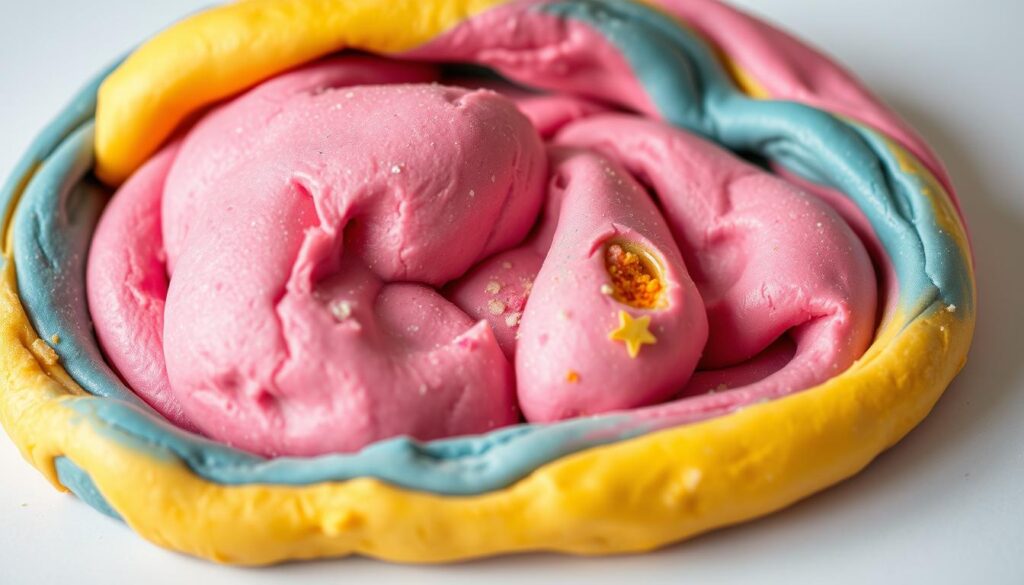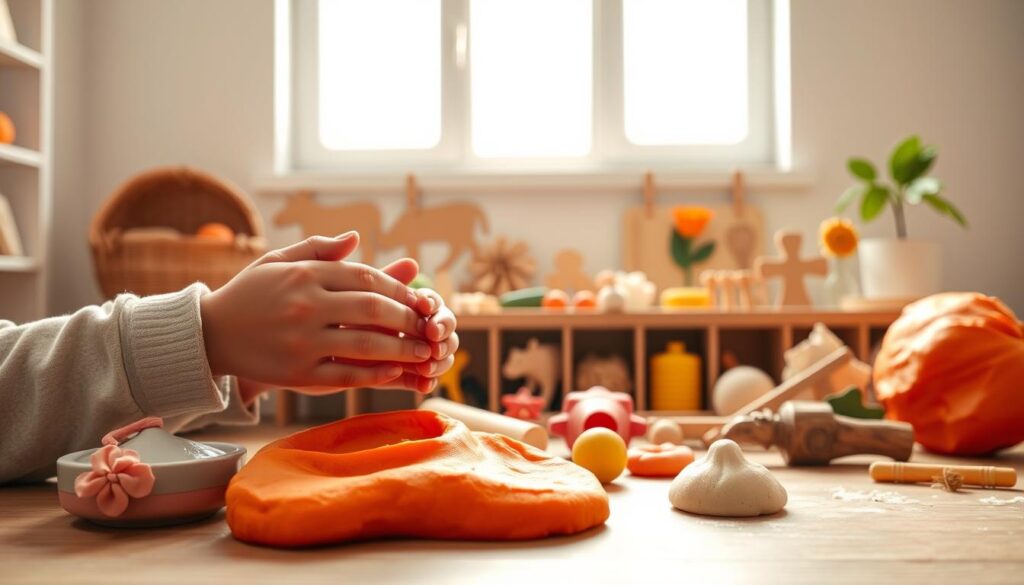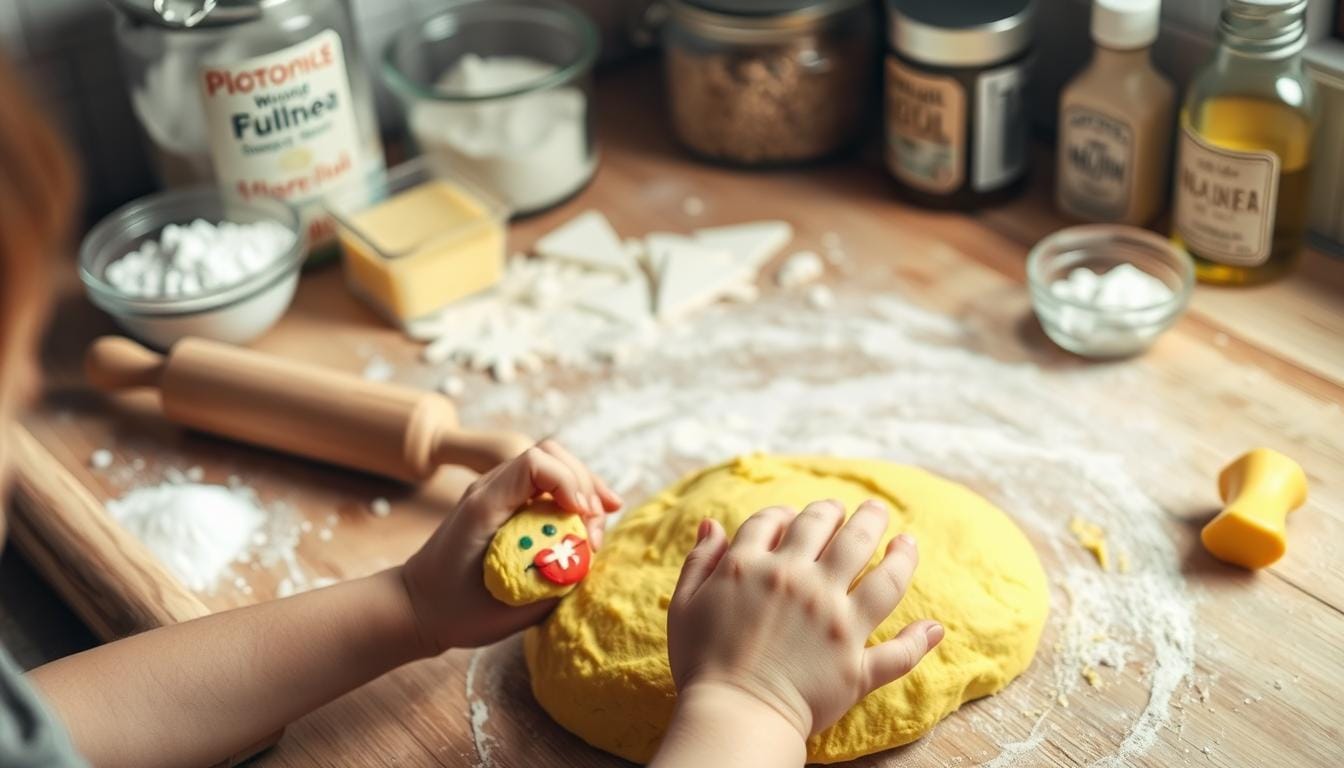Playdough recipe without cream of tartar for fun DIY projects
playdough recipe without cream of tartar
Looking for a fun activity to do with your kids or to relax? Making DIY playdough is a great choice. It’s a fun way to spark creativity and imagination. Plus, you can make different textures and colors, perfect for family fun.
Usually, cream of tartar is in playdough recipes. But, you can make similar playdough without it. This is handy if you don’t have it or don’t want to use it. The playdough turns out soft and easy to shape.
Customizing your playdough is easy. You can add colors, scents, or textures to make each batch special. This makes making playdough a fun and rewarding activity.
Why Make Homemade Playdough Without Cream of Tartar
Making playdough without cream of tartar is easy. You only need common household items. This makes the recipe simple and accessible to all.
Benefits of Cream of Tartar-Free Recipes
One big plus of cream of tartar-free playdough is using ingredients you probably have at home. This easy homemade playdough recipe saves you from extra trips to the store. It’s a handy option.
- Simplifies the recipe by using common ingredients
- Reduces the need for specialized ingredients
- Offers a cost-effective alternative to store-bought playdough
Common Household Ingredients as Alternatives
For no cream of tartar playdough, you can use everyday items. Flour, water, and salt make a cream of tartar-free playdough recipe. It’s fun and engaging.
- Flour gives the dough texture and structure.
- Water makes the dough the right consistency.
- Salt adds a fun touch and helps keep the dough fresh.
Essential Ingredients for Homemade Playdough
Making homemade playdough without cream of tartar is easy with the right ingredients. You’ll find it simple to create using common household items.
Basic Pantry Staples You’ll Need
The key to great homemade playdough is its basic ingredients. You’ll need flour as the main ingredient, giving it structure and texture. Salt is also important, helping keep the dough fresh and adding texture.
You’ll also need cornstarch or corn flour to make the dough smooth and prevent stickiness. Water is essential, as it holds everything together.
Ingredient Substitutions and Alternatives
One great thing about homemade playdough is you can swap out ingredients. You can use all-purpose flour or whole wheat flour for different textures and colors. If you don’t have cornstarch, try arrowroot powder or tapioca flour instead.
Trying different ingredients lets you make playdough that’s just right for you. You can change the texture and color with each batch, making it fun and personal.
Simple Playdough Recipe Without Cream of Tartar
Here’s a simple recipe for homemade playdough without cream of tartar. It’s great for parents, teachers, and anyone wanting to have fun making something. You only need common household items, making it easy for everyone to try.
Ingredient Measurements and Proportions
To make this playdough, you’ll need the following ingredients in the specified proportions:
| Ingredient | Quantity |
|---|---|
| Flour | 2 cups |
| Salt | 1/2 cup |
| Water | 1 cup |
| Vegetable Oil | 2 tablespoons |
| Food Coloring (optional) | A few drops |
Jane Smith, a renowned child development specialist, once said, “The quality of the materials used in playdough can significantly impact a child’s sensory experience.”
“Using the right ingredients can make all the difference in creating a smooth, pliable playdough that children love.”
Step-by-Step Mixing Instructions
Follow these steps to mix your playdough:
- In a large mixing bowl, combine the flour and salt.
- Gradually add in the water, stirring with a spoon until the mixture is well combined.
- Add the vegetable oil and continue stirring until the dough starts to form.
- If desired, add a few drops of food coloring to tint your playdough.
- Knead the dough on a floured surface until it’s smooth and consistent.
By following these simple steps, you can create a high-quality playdough without cream of tartar that’s perfect for various DIY projects and activities.
How to Make Playdough Without Cream of Tartar: Cooking Methods
Making playdough without cream of tartar means trying different cooking ways. These methods make playdough just as fun and soft. The cooking step is key to getting the right feel and look.
Stovetop Cooking Process
The stovetop method lets you control the heat closely. This is important for making a dough that’s smooth and easy to shape. Start by mixing dry ingredients and slowly add wet ones while stirring on medium heat. This keeps the dough even and lump-free.
Key steps include:
- Constantly stirring the mixture to avoid burning.
- Monitoring the temperature to prevent overheating.
- Adjusting the heat as necessary to achieve the desired consistency.
No-Cook Alternative Method
If you want something quicker and simpler, try the no-cook method. Just mix all ingredients in a bowl until they stick together. This method is great because it’s fast and doesn’t risk burning.
Benefits of the no-cook method include:
- Less risk of burning the mixture.
- No need for constant supervision or stirring.
- A faster overall preparation time.
Both ways let you make easy homemade playdough for fun projects. Pick the method that fits your style for a creative playdough experience.
Adding Colors to Your DIY Playdough
Get creative by adding colors to your playdough. This makes it more fun and engaging. You can try out different colors and mixes to make it your own.
Natural Food Coloring Options
Choose natural food coloring for your playdough. It’s safer for kids and adds fun. Here are some great options:
- Beet juice for pink and red shades
- Turmeric for vibrant yellows
- Spirulina for greens and blues
- Coffee or cocoa powder for browns and tans
These ingredients can be used alone or mixed for the perfect color. Craft experts say, “Natural ingredients make your DIY projects safer and more creative.”
Creating Custom Color Combinations
Mixing colors lets you create unique shades for your playdough. Here’s how to mix colors:
- Start with primary colors (red, blue, and yellow) and mix them to create secondary colors.
- Experiment with different ratios of colors to achieve the desired hue.
- Add a touch of white or black to lighten or darken your colors.
By trying out different color mixes, you can make a playdough recipe without cream of tartar that’s truly yours. It’s not just fun but also educational for kids.
For a simple playdough recipe without cream of tartar, start with the basic recipe. Then, add your favorite colors. Making your own playdough at home is very flexible.
Enhancing Your Homemade Playdough with Scents and Textures
You can make your no cream of tartar playdough even better by adding scents and textures. This makes it more fun and good for kids. It helps them use their senses and be creative.

Safe Scent Additions for Sensory Play
When adding scents, choose safe and non-toxic ones. Here are some good options:
- Essential oils: Lavender and chamomile can help kids relax.
- Scented extracts: Vanilla and almond extracts smell nice.
- Fragrance oils: Some are made just for kids and are safe.
Make sure any scent you pick is safe for kids and follows the maker’s advice.
Texture Enhancers for Tactile Development
Adding textures makes playdough better for kids’ hands and keeps them interested. Try these:
- Glitter: It sparkles and kids love it.
- Sand or fine grains: It’s gritty and fun to touch.
- Sequins or small beads: They add a cool feel and look.
By mixing scents and textures, you make playdough that’s fun and educational.
Storing and Preserving Your Homemade Playdough
Keeping your homemade playdough fresh is key. When stored right, it stays good for longer.
Proper Storage Containers and Methods
Use airtight containers for your playdough. You can pick from plastic or glass jars with tight lids. Make sure they’re clean and dry to avoid contamination and moisture.
Tips for Storage:
- Keep containers away from sunlight and heat.
- Store them in a cool, dry spot, like a cupboard or drawer.
- Keep different colors separate to avoid mixing.
Extending the Life of Your DIY Playdough
Here are some tips to make your playdough last longer:
| Method | Description | Benefit |
|---|---|---|
| Keep it Clean | Ensure hands are clean before handling playdough | Prevents contamination |
| Avoid Moisture | Keep playdough away from humid environments | Reduces drying out or stickiness |
| Revive with Oil | Add a few drops of oil if playdough becomes dry | Restores pliability |
By using these tips, you can enjoy your homemade playdough for a longer time. This makes the most of your best playdough recipe without cream of tartar and playdough recipe with common household ingredients.
10 Fun DIY Projects Using Your Homemade Playdough
Now that you have homemade playdough, you can start many fun and educational activities. These activities are great for all ages and interests. They use your DIY playdough without cream of tartar.
Educational Activities for Different Age Groups
Young kids can improve their fine motor skills by playing with playdough. They can roll, shape, and mold it. Older kids can try making specific shapes or models that need more skill and patience.
Learning can be fun with playdough. Kids can make the alphabet, count shapes, or even copy historical items. It makes learning interactive and enjoyable.
Creative Playdough Crafts and Models
With your homemade playdough, you can make lots of crafts and models. Kids can create animals, flowers, or even abstract art. They can also make complex models like buildings or vehicles.
Using different colors and textures makes these projects even more fun. They become more engaging and beautiful to look at.
Seasonal and Holiday-Themed Playdough Ideas
Playdough can be themed for different seasons and holidays. For Christmas, kids can make trees, stars, or snowmen. Halloween brings spooky figures like ghosts, bats, or pumpkins. Easter can be celebrated with bunny and egg shapes.
These themed activities make playdough more exciting. They also help kids learn about and celebrate different times of the year through creative play.
Developmental Benefits of Playdough Play
Playing with homemade playdough is great for kids. It lets them show their creativity and learn important skills.

Easy homemade playdough is good for kids’ fine motor skills. They get better at hand-eye coordination and dexterity by playing with it.
Fine Motor Skills Development
Using no cream of tartar playdough helps kids improve their fine motor skills. They learn to roll, shape, and mold the dough. This makes their hand and finger muscles stronger, getting them ready for writing.
Playing with playdough also helps kids get better at handling objects. This skill is key for doing well in school.
Cognitive and Creative Growth Through Sensory Play
Playing with easy homemade playdough boosts kids’ thinking skills. They get to try out different textures and colors. This helps them understand the world better.
Playdough also lets kids use their imagination and solve problems. This helps them grow in many ways.
Troubleshooting Common Playdough Problems
With a few simple adjustments, you can overcome common playdough problems and enjoy your homemade creation. Making playdough at home can be a fun and rewarding experience, but it’s not without its challenges. Whether you’re using a simple playdough recipe without cream of tartar or a more complex one, issues like dryness, stickiness, or crumbliness can arise.
To address these issues, it’s essential to understand the causes and solutions. One of the most common problems is dry or crumbly playdough, which can be frustrating to work with.
Fixing Dry or Crumbly Playdough
Dry or crumbly playdough is often caused by overcooking or using too much flour. To fix this, you can try adding a small amount of water or oil to the mixture and kneading it until it becomes smooth and pliable. As craft expert Jane Smith notes, “The key to fixing dry playdough is to add moisture gradually and knead thoroughly.” If the playdough is too dry, you can also try adding a little more water and kneading until it reaches the desired consistency.
Solutions for Sticky or Too-Soft Playdough
On the other hand, sticky or too-soft playdough can be caused by using too much water or not enough flour. To fix this, you can try adding a small amount of flour to the mixture and kneading until it becomes smooth and manageable. As she says, “It’s all about balance when it comes to playdough texture.” If the playdough is too sticky, you can also try adding a little more flour and kneading until it reaches the desired consistency.
“The best way to achieve the perfect playdough texture is to experiment and adjust the ingredients according to your preference.” – Jane Smith, Craft Expert
By following these troubleshooting tips, you can overcome common playdough problems and enjoy your homemade creation. With a simple playdough recipe without cream of tartar, you can create a fun and engaging DIY project for kids and adults alike.
Comparing Homemade vs. Store-Bought Playdough
Homemade playdough is becoming more popular. It offers a big advantage: you control the ingredients. This is great for kids with allergies or sensitivities.
Let’s look at cost and environmental impact. Making your own playdough can save money and be better for the planet.
Cost Analysis and Savings
Making your own playdough can save you money. Here’s a comparison:
| Product | Cost | Quantity | Cost per Unit |
|---|---|---|---|
| Store-Bought Playdough | $5 | 1 container | $5 |
| Homemade Playdough | $1.50 | 4-6 containers | $0.25-$0.375 |
The table shows homemade playdough can save a lot, which is good for families or schools.
Environmental and Health Benefits
A study found that kids are exposed to harmful chemicals in products.
“Making homemade playdough with natural ingredients can lower this risk.”
By making your own, you use safe ingredients. This makes playdough healthier for kids.
Homemade playdough also cuts down on packaging waste. Choosing a cream of tartar-free playdough recipe is better for the environment. It fits with the trend of living sustainably.
In summary, making your own playdough saves money and helps the environment. The best playdough recipe without cream of tartar is safe, affordable, and eco-friendly.
Conclusion
Making your own playdough without cream of tartar is easy and fun. It’s a great DIY project. You can use common household items to create different playdough recipes for kids and adults.
This article shows you how to make playdough with simple recipes. You can try different colors, textures, and scents. Making your own playdough saves money and is better for the environment.
Learning to make DIY playdough without cream of tartar is easy. You just need basic pantry items and simple cooking steps. Now, you can make your own playdough and help your kids develop important skills.
So, get your ingredients ready and start making your own playdough. Try out different recipes and colors. It’s a fun and educational way to play.

